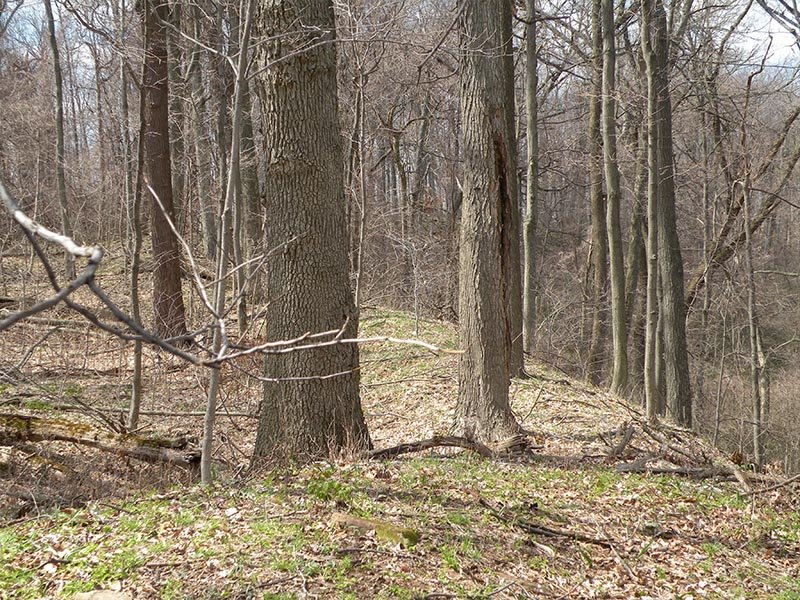The Earthen Wall along the Fort Trail
Fort Hill
Fort Hill Earthworks. This 1495-acre preserve protects a 2000-year-old large earthen-walled ceremonial enclosure on its flat ridgetop. This enclosure was constructed by Native Americans an estimated 2,000 years ago. Fort Hill is managed by the Arc of Appalachia on behalf of Ohio History Connection. The Arc of Appalachia has expanded what was originally a 1,200-acre park with five property acquisitions, adding 400 acres to the greater Fort Hill Preserve region. This preserve is a hiker’s paradise with its limestone boulders and cliffs bordering the Baker Fork, stone arches, towering ancient trees, a high diversity of botanicals, and outstanding spring wildflower displays.
Hiking: Sunrise to Sunset
Address: 13614 Fort Hill Road, Hillsboro, OH 45133
Download and Go! - Hiking Guide and More Information
A dog owner's guide to hiking the Arc of Appalachia

The picnic shelter can be reserved please call ahead at 937-365-1935.

Wherry’s catchfly

Fort Hill has a truly spectacular spring wildflower display.

Fort Hill shelters one of the largest and oldest contiguous forests in all of Ohio.

To hike the Canby’s Mountain Lover Trail you do need to cross the creek - this is best hiked in the summer

Stone Arch along the Gorge Trail


The Fort Hill Earthwork can be accessed by following the Fort Trail. The feature may not be immediately noticeable.
Ancient earthworks. Fort Hill is an ancient earthen-walled enclosure atop a large flat-topped ridge, constructed by Native Americans an estimated 2,000 years ago. Most likely it was not a fort, but rather a ceremonial gathering space. Its architects were of the Hopewell culture, representing an extremely artistic and influential era in the eastern United States. People of the Hopewell culture erected as many as 36 large complexes of high-walled enclosures on the floodplains of southern Ohio in shapes of precise circles, squares, and hexagons. Additionally, they built at least a dozen irregular hilltop enclosures, including Fort Hill.
The earthen-stone wall’s circumference is more than one and a half miles, with thirty-six definite man-made openings and possibly three more such openings. The wall itself ranges from 6 to 15 feet in height, averages 30 feet wide at its base, and encloses 35.3 acres. It follows the natural contour of the rim of the hill and is bordered on the inside wall by a substantial ditch.
The Fort Hill Earthwork can be accessed by following the Fort Trail, which follows the perimeter of the enclosure. It appears as a rounded rim of earth bordering the bluffs of the entire ridge top. The feature may not be immediately noticeable until you realize that what you are seeing cannot possibly be explained by geological processes.
A second extremely well-preserved earthwork exists on the south side of the preserve, composed of a circular walled enclosure with a diameter of approximately 170 feet and a height of 2.5 to 3 feet. Archaeologists have discovered two concentric circles of post holes that once outlined this earthwork, but no supporting posts in the middle of the enclosure. It is theorized that the original structure may have had fenced walls or a circular arbor rather than a roofed building. Artifacts recovered from a nearby archaeological site included flint chips, worked mica sheets, and one piece of obsidian blade, all indicating a Hopewell-era construction. It is conjectured that this area may have been an artisan workshop and/or a short term habitation site, possibly accommodating visitors making the journey to the Fort Hill ceremonial complex.
Old growth forest: Fort Hill shelters one of the largest and oldest contiguous forests in all of Ohio. The park is connected to other preserve lands and to Pike State Forest, creating a large block of contiguous forest of the kind that is critical for deep forest inhabitants such as cerulean and worm-eating warblers, ephemeral spring wildflowers, and many rare plants. It is estimated that the park preserves over 800 vascular species of plants within its boundaries, an outstanding remnant of the temperate deciduous forest that once covered nearly all of the eastern United States. In 2015 Fort Hill was officially inducted into the Old Growth Forest Network.
Fort Hill floral displays: Fort Hill has a truly spectacular spring wildflower display including such showy species as large-flowered trilliums, columbine, celandine poppy, and Sweet William woodland phlox. Hiking the gorge trail in mid-April is an enchanting experience.

